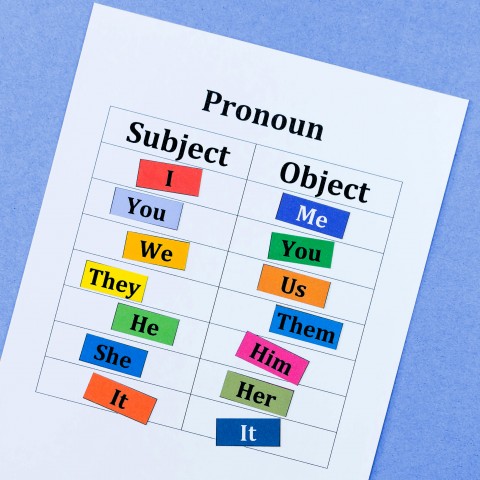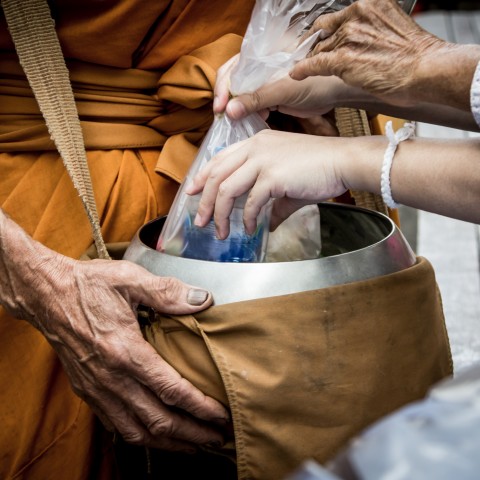In many languages, หลักภาษา (lhàk-phaa-sǎa), or “grammar,” is one of the most difficult aspects to learn. Fortunately for you, Thai grammar is notorious for its relatively simple rules and structures when compared to other languages.
Still, if you’re thinking about learning Thai or have recently started, you may have several questions concerning Thai grammar: Are there a lot of Thai grammar rules? Should I learn the Thai alphabet and grammar together, or would it be too hard? On this page, you’ll get answers to all of your Thai grammar questions.
- → Keep in mind that if you want to explore this topic further, ThaiPod101.com has more resources for you: Introduction to Thai Grammar and Painless Thai Grammar. Check them out!
 Table of Contents
Table of Contents
- Thai Grammar vs. English Grammar – The Basics
- Parts of Speech
- Unique Thai Grammar Concepts
- Conclusion
1. Thai Grammar vs. English Grammar – The Basics
As you know, the grammar of any language is supported by several grammar rules that must be followed. To make matters worse, the vast majority of these rules have a number of exceptions that can only be learned through memorization. When combined, these two factors tend to make people nervous about studying another language’s grammar.
However, as we mentioned a moment ago, you’re not going to have very many issues with this when studying Thai grammar. As a matter of fact, there are very few fixed rules in Thai grammar. Not only that, but the few rules that do exist are very easy to understand.
Since you’re reading this page, you’re most likely a native English speaker or someone who has been studying English a long time. In order to help you fully appreciate how easy it can be to master Thai grammar, we’ll be using English as a benchmark.
Now, let’s look at two crucial grammar elements you should understand before continuing: Thai sentence structure and verb conjugation.
- → Wondering how to learn Thai grammar effectively? See our video lesson on the 4 Ways to Improve Your Grammar!
1 – Sentence Structure
Like English, Thai expresses complete ideas (sentences) through the use of subjects, verbs, and objects.
Both languages use the SVO (Subject + Verb + Object) structure for basic sentences:
- I (S) drink (V) coffee (O).
However, Thai people sometimes use OVS (Object + Verb + Subject), which is the passive form, when they want to focus on the object.
- The glass (O) broke (V) I (S).
- I broke the glass.
See? There aren’t too many differences between the Thai and English sentence structure rules!
2 – Verb Conjugation
In English, and many other languages, verbs need to be conjugated depending on factors such as tense, mood, number, and gender.
Well, we have some more good news for you: There’s no verb conjugation in Thai grammar! Better yet, Thai doesn’t have tenses to begin with. In other words, there’s no need to worry about any of the factors you may be concerned with in English. Just use the verb as-is and include other words (such as time words) to add context as needed.
2. Parts of Speech
That was easy, right? Now let’s go into more detail about the different parts of speech in Thai, and how they compare to their English counterparts.
1 – Nouns
คำนาม (kham-naam), or Thai nouns, are grammatically categorized into five types:
- สามานยนาม (sǎa-maan-yá-naam)
- วิสามานยนาม (wí-sǎa-maan-yá-naam)
- สมุหนาม (sà-hmù-hà-naam)
- ลักษณะนาม (lák-sà-nà-naam)
- อาการนาม (aa-gaan-rá-naam)
You may be wondering if having these different types makes learning grammar hard. Not at all. There’s no need to be able to categorize the nouns as long as you can use them correctly.
When compared to English nouns, those in Thai are far easier to get the hang of. This is because Thai grammar doesn’t have articles, use noun declension, or separate countable and uncountable nouns.
One thing you may need to get used to is that Thai nouns are used differently with adjectives than those in English are. Instead of using “adjective + noun” like English does, Thai uses “noun + adjective.”
- → If you want to expand your vocabulary, visit our video lesson on the Top 25 Thai Nouns!

2 – Pronouns
คำสรรพนาม (kham-sàp-phá-nam), or Thai pronouns, are grammatically categorized into six types:
- บุรุษสรรพนาม (bù-rùt-sàp-phá-naam)
- ประพันธสรรพนาม (bprà-phan-thá-sàp-phá-naam)
- นิยมสรรพนาม (ní-yá-má-sàp-phá-naam)
- อนิยมสรรพนาม (à-ní-yá-má-sàp-phá-naam)
- วิภาคสรรพนาม (wí-phâak-sàp- phá-naam)
- ปฤจฉาสรรพนาม (bprùet-chǎa-sàp-phá-naam)
Like with the noun categories, you don’t need to worry too much about memorizing these.
One similarity between Thai and English grammar is that they both make use of personal pronouns. However, once you start learning Thai, you’ll see that Thai has more pronouns than English does. Still, they’re not too hard to remember!
As for differences, you’ll notice that relative clauses and question words are considered pronouns in the Thai language. But does this make Thai grammar difficult? Not really, as the most important thing is that you know how to use them correctly.
- → Make sure to check out our vocabulary list of the Most Useful Thai Pronouns so you don’t get lost in the huge number of pronouns we have!

3 – Verbs
คำกริยา (kham-gà-rí-yaa), or Thai verbs, are grammatically categorized into four types:
- อกรรมกริยา (à-gam-gà-rí-yaa)
- สกรรมกริยา (sà-gam-gà-rí-yaa)
- วิกตรรถกริยา (wí-gà-dtàt-thà-gà-rí-yaa)
- กริยานุเคราะห์ (gà-rí-yaa-nú-khráw)
As you can guess, there’s no need to remember the name of each type or to know which verb belongs to which category. You just need to use them correctly, which is very easy to do.
As mentioned before, Thai has no tense or verb conjugation. This means that you don’t have to worry about changing a verb’s form for tense, mood, number, or gender like you would in many other languages.
Both Thai and English use auxiliary verbs, but they’re much simpler to use in Thai. The auxiliary verb is simply put in front of the verb, and that’s it. There’s no need to consider the subject or change the verb form.
- → Verbs are an essential part of speech, so it’s important that you know the most common ones. See our lesson on the Top 25 Thai Verbs to get a head start!
4 – Adjectives and Adverbs
In Thai grammar, adjectives and adverbs are treated differently than they are in English. Namely, Thai people don’t separate adverbs and adjectives, but view them as one grammar element called คำวิเศษณ์ (kham-ví-sèet). They’re categorized into ten types, which you don’t need to remember at all in order to use them correctly.
- → Do you want more information on this? Visit our lesson on Using Thai Adjectives!
3. Unique Thai Grammar Concepts
Not everything in Thai grammar is similar or comparable to English; there are certainly some unique Thai grammar rules, too. We’ll give you a few examples so that you get the idea.

1 – คำราชาศัพท์
Thai people use different words and phrases when speaking with the royal family or monks. This is an advanced Thai grammar component and it’s not very easy to learn—most Thai people don’t even use it correctly. It’s like you have to learn a new set of words. Here are some examples:
| English meaning | Normal Thai word | Thai word for royal family | Thai word for monks |
| eat | กิน (gin) | เสวย (sà-wǒoei) | ฉัน (chǎn) |
| sick | ป่วย (bpùuai) | ทรงพระประชวร (song-phrá-bprà-chuuan) | อาพาธ (aa-phâat) |
| food | อาหาร (aa-hǎan) | พระกระยาหาร (phrá-grà-yaa-hǎan) | ภัตตาหาร (phát-dtaa-hǎan) |

2 – A Special Type of Pronoun
In Thai, there’s a pronoun type called วิภาคสรรพนาม (wí-phâak-sàp-phá-naam). This type of pronoun is used with a group of nouns to show whether each component of that group performs the same action or not.
For example, ทุกคนต่างช่วยกันทำงาน (thúk-khon-dtàang-chûuai-tham-ngaan) means “each of everyone is helping each other working,” or in other words, “everyone works together.”
There is no pronoun or word like this in English.
3 – Numeric Classifiers
Numeric classifiers and quantifiers, or ลักษณะนาม (lák-sà-nà-naam), describe the physical characteristics of a noun. For example, in English you would say, “two bottles of milk” or “three pieces of cake.” The concept is similar to numerical classifiers in Thai language.
4. Conclusion
By now, you should know that Thai language grammar isn’t that hard to learn. Why?
To recap:
- Thai and English use the same SVO word order for basic sentences.
- Thai doesn’t have verb conjugation or verb tenses.
- Thai doesn’t take things like plurals or gender into consideration.
- Thai doesn’t have noun declension.
- Thai doesn’t use articles with its nouns.
Are you interested yet?
If you decide to continue learning Thai and want to know more about Thai grammar, don’t waste any time trying to find a good Thai grammar book. You’re already looking at the best option for learning Thai grammar: ThaiPod101.com! We provide our students with various lessons on the Thai language and culture, such as these:
- The Top 5 Reasons to Study Thai
- The Top 5 Things You Need to Know About Thai Society
- Introduction to Thai Pronunciation
Of course, you can also click on any of the links we provided throughout the article to get more information on something we covered.
So, what do you think? Do you find Thai grammar easy or pretty difficult so far? Let us know in the comments!










